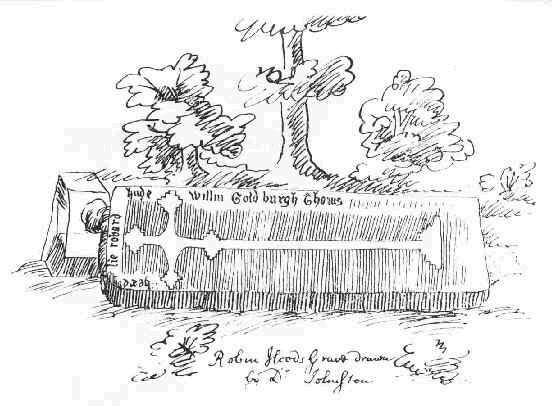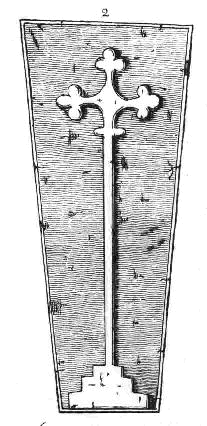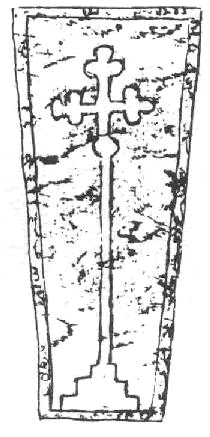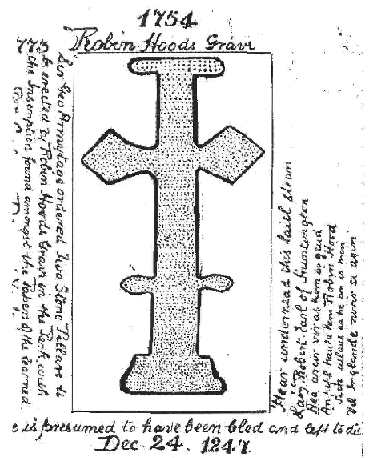Robin Hood’s Grave 7

This drawing has been attributed to Dr. Nathaniel Johnston, however it is a copy of one that is among William Stukeley’s archives at the Bodleian Library, which is possibly a copy of Johnston’s original. The Bodleian drawing differs slightly from the one shown here.


The drawing on the left is ‘The figure of the stone over the grave of Robin Hood’, from Richard Gough’s Sepulchral Monuments in Great Britain 1786.(1) As can be seen, it differs from the Johnston/Stukeley drawing, and looks somewhat similar to that on the right; one of the Robin Hood relics at St. Anne’s Well Nottingham, from Thoroton’s History of Nottinghamshire, ed. J. Throsby, 1797. In the sixteenth century, St. Anne’s Well was already known as Robin Hood’s Well, and the site was visited by many seventeenth and eighteenth century travellers, who were shown some of Robin’s supposed belongings, such as his chair, bow, arrows, cap and slipper.

The above is one of the drawings (all similar) of Robin’s gravestone by Joseph Ismay; an almost identical sketch also appears in Dr Whitaker’s History of Loidis and Elmete 1816. Sir Samuel Armytage of Kirklees appointed Ismay as tutor for his children, and he drew the gravestone in 1752 and 1754; although he admits his work is a ‘rough sketch,’ it is obvious that the cross is entirely different to that which appears in the Johnston/Stukeley drawing.
In 1715, Richard Richardson wrote to the Leeds antiquarian Ralph Thoresby. ‘The inscription upon Robin Hood’s grave was never legible in my time; and it is now totally defaced; insomuch that neither the language nor character is to be distinguished; only you may perceive it was written about the verge of the stone. I have heard Dr Armitage(2) say, (who was most part of his time at Kirklees,) that he could read upon it Hic jacet Robertus Hood, filius secundus Comitis de Huntingdon, but I must own, tho’ he was a person of merit, I give little credit to this report.’ Richardson must have seen the gravestone drawn by Johnston, as he mentions the faint inscription on the verge (edge) of the stone. John Watson was guided around Kirklees estate, and in his unpublished notes on Kirklees dated 1758, was written the following. ‘At some distance from this (Castle Field Kirklees Park), in an inclos’d Plantation is Robin Hood’s tomb, as it is call’d; which is nothing but a very rude stone note quite two yards long, & narrow in proportion; it has the figure of a cross, cut in a manner not common upon it; but no inscription, nor does their appear ever to have been any letters upon it, notwithstanding Mr. Thoresby has publish’d a pretended one found amongst the papers of Dr. Gale Dean of York’. Although Watson appears to have confused the gravestone with the epitaph, there clearly was no sign of an inscription; either it had worn off completely, or the stone described by Watson was a replacement for the original. His comment that the cross was ‘not common’ is probably a reference to that which appears in the above drawing by Ismay; it is difficult to imagine this is the same stone drawn by Johnston.
1. The accuracy of some of Gough’s drawings has been brought into question; he was William Stukeley’s friend.
2. Dr Armytage became Sir Samuel after moving to Kirklees in 1736.
This page contains information from the paper, A Grave Tale by David Hepworth.


|